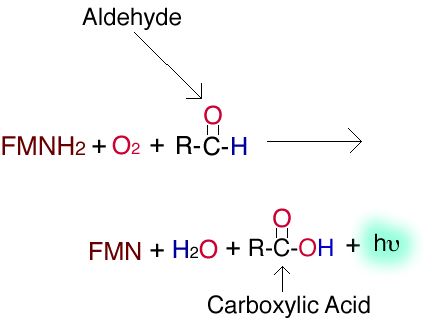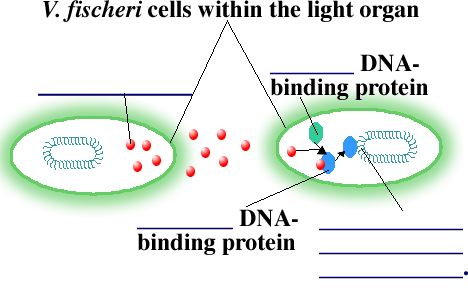Lecture #7: Bioluminescence
I. Bioluminescence is the ___________________________________
seen when an organic compound (an aldehyde) is oxidized by the enzyme called
__________________.
A. Demonstrated by bacteria in the genera ______________________
and ____________________________.
B. Biochemistry: A long-chain ____________________
is oxidized to form a _______________________________.
Flavin mononucleotide serves as an electron donor and molecular oxygen as
an electron acceptor. The ___________________________________________,
stabilized by the enzyme is thought to be the direct source of the ______________________.

C. The electrons used for luminescence are diverted from the electron transport
chain and _______________ synthesis. Thus,
the process costs the bacteria a considerable amount of
______________________. So why do it?
II. The ____________________ relationship
between _______________________ _______________
and __________________________.
A. E. scolopes
1. A small ________________ that lives
in the shallow waters off the coast of Hawaii and feeds at night under the
moonlit/starlit sky.
http://www.dal.ca/~ceph/TCP/Escolopes.html
2. This small squid has a special organ, called the _________________
_______________ that is colonized by the bioluminescent bacterium
V. fischeri. The light-production by V. fischeri affords the
squid a bit of camouflage by keeping it from casting a ___________________
onto the ocean floor, and thus protecting it from ________________.
B. Amazingly the light organs of juvenile squids begin to glow with a ______________________________
of V. fischeri only _______________
after hatching. Following are some current ideas as to how this very exclusive
relationship is established.
1. On the squid’s light organ, two ciliated fields that surround three
pores leading to the organ’s interior, serve to ___________________
_____________________________________________.
2. Once through the pore, bacteria are further weeded out as they must _______________________________________________________
in order to enter small spaces within the light organ called crypts.
3. Inside the crypt, bacteria encounter _________________________
_____________________________________. These cells are likely
responsible for the removal of cells other than V. fischeri that
manage to make it into the crypt.
4. V. fischeri _____________________________________________
___________________ allowing the symbiotic relationship to become
more intimate.
*Note-bacterial cells also play a role in specific selection
(e.g. nonflagellated cells are incapable of colonization and recent
research shows that the interaction of the host with bacterial LPS
induces the release of bacterial cytokines that signal the squid
to secrete mucus onto the ciliated fields (McFall-Ngai et. al).)
5. The squid secretes an active ________________________________
that kills any remaining nonspecific cells.
C. Quorum sensing
1. Once selected for, a ______________________________________
of V. fischeri cells are cultivated in the crypts (1011
cells/mL).
2. It is only at this high concentration that V. fischeri cells can
communicate with one another using ________________________
________________________.
a. Cells secrete autoinducers and when neighboring cells are in close
proximity, the autoinducers ______________________
_________________________________________.
b. The autoinducers bind to proteins that _________________
______________________________. Thus, it is only at high cell
concentration that ________________________________
___________________.

References:
Visick, K.L. and McFall-Ngai, An Exclusive Contract: Specificity
in the Vibrio fischeri-Euprymna scolopes partnership, Journal
of Bacteriology, 182, 1779.
McFall-Ngai et. al., Roles of Vibrio fischeri
and Nonsymbiotic Bacteria in Dynamics of Mucus Secretion During Symbiont
Colonization of Euprymna scolopes light organ, Applied
and Environmental Microbiology, 68, 5113.
|

